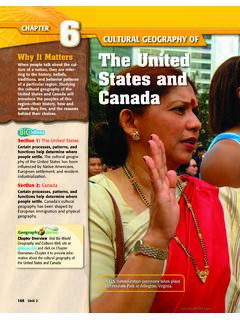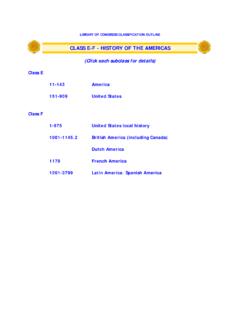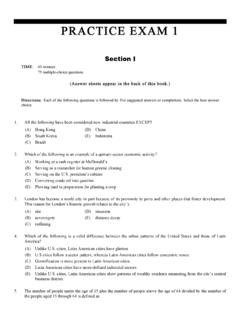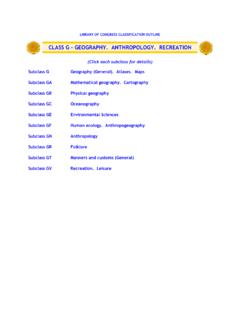Transcription of Chapter 9: The Cultural Geography of Latin America
1 GeoJournalAs you read this Chapter , use your journal tolist and describe the Cultural influences thathave shaped life in Latin America . Note howboth native and imported cultures haveformed a uniquely Latin American way of OverviewVisit the Glencoe WorldGeographyWeb site at click on Chapter Overviews Chapter 9 to preview information about the Cultural Geography of the PatternsA Geographic ViewA Flavorful MixMore than any other Caribbeanisland, Trinidad is a multiethnicstew. Africans and East Indians,each with about 40 percent of thepopulation, make up the base,while smaller groups add theirown flavor. Spanish and Frenchfamilies trace their roots to the18th century, when their ances-tors came to clear the land forplantations or to trade.. Portuguese, Chinese, and Syrian immigrants becamemerchants and Trinidadians comparethe resulting mix to callaloo, a soup with many ingredients. A. R. Williams, The Wild Mix of Trinidad and Tobago, National Geographic, March 1994 The island countryof Trinidad and Tobago reflects inminiature Latin America s diverse population.
2 In this section you willlearn how Latin America s multiethnic population came about, howthe land shaped patterns of human migration, and what benefits andchallenges population growth and diversity bring to the CharacteristicsLatin America s 525 million people about 9 percent of the world spopulation live in 33 countries that span more than half of the Western Hemisphere. The region s population includes Native Americans, Europeans, Africans, Asians, and mixtures of thesegroups. The bar graph on page 212 shows you the ethnic diversitythat characterizes Latin America to ReadingConsider What You KnowThink about what you have readabout the physical Geography ofLatin America . What geographic factors influence where people have settled in this region?Read to Find Out What ethnic groups make up thepopulation of Latin America ? How have Geography and eco-nomics influenced the distributionof Latin America s population? How has migration affected theLatin American culture region?
3 In what ways does Latin America scultural diversity present bothbenefits and challenges for itspeople?Terms to Know indigenous dialect patois urbanization megacity primate cityPlaces to Locate Ecuador Caracas Peru Santiago Bolivia Patagonia Guyana Rio de Janeiro Buenos Aires BarbadosChapter 9211 Woman at a Guatemalan marketTrinidad s Laventille neighborhood212 Unit 3 HistoryA Blending of PeoplesThe ancestors of Native Americans were the firstpeople to settle Latin America . As a result, NativeAmericans today are known as an indigenous(ihn DIH juh nuhs) group, people descendedfrom an area s first inhabitants. Centuries ago threeNative American groups the Maya of the Yucat nPeninsula and parts of Central America , the Aztecof Mexico, and the Inca of Peru s highlands developed great civilizations with important citiesand ceremonial many Native American Cultural featuresstill remain in parts of Latin America . Most of LatinAmerica s present-day Native Americans live inMexico, Central America , and the Andes region ofEcuador, Peru, and Bolivia.
4 In areas where they area large part of the population, Native Americanpeoples have worked to preserve their traditionalcultures while adopting features of other first arrived in what is now LatinAmerica in the late 1400s. Since that time millionsof European immigrants have come to the of these settlers were Spanish and the years other European groups Italians,British, French, and Germans came as well. In mod-ern times so many Europeans settled in Argentina andUruguay that these countries became known as immi-grant nations. In Latin America today, descendants ofEuropean immigrants continue to follow many of theways of life their ancestors brought with first came to Latin America in the arrived as enslaved people, brought forcibly byEuropeans to work sugar and other cash crop plan-tations in Brazil and the Caribbean islands. The laborof enslaved Africans helped build Latin Americaneconomies. By the late 1800s, slavery had finallyended in the region.
5 Many Africans whose familieshad been in Latin America for generations remainedin parts of the region. They added their rich culturalBrazilGuyanaVenezuelaArgentinaGu atemalaDominicanRepublicPeruMexico0 2040608010085%15%6%38%55%10% 2%67%21%32%6%12%49%11%16%73%30%60%9% 1%1%1%44%56%45%37%15%3%* Two or more ethnic groupsSource: World Almanac, 2001 GRAPH STUDYE thnic Groups in Selected Latin American CountriesAfricanNative AmericanMixed*S Asian/SE GraphsWhich country has the larg-est percentage of people ofEuropean heritage in its population? GeographySkillsWhat factors helpedinfluence the ethnic variety in Latin America ? Chapter 9213influences to the food, music, arts, and religions ofLatin first settled in Latin America during the1800s. They labored as temporary workers, andmany remained to form ethnic the Caribbean islands and some countriesof South America have large Asian populations. InGuyanaabout one-half of the population is ofSouth Asian or Southeast Asian descent.
6 Manypeople of Chinese descent make their homes inPeru, Mexico, and Cuba, and many people ofJapanese descent live in Brazil and the centuries there has been a blending of these different ethnic groups throughout LatinAmerica. For example, in countries such as Mexico,Honduras, and El Salvador, people of mixed NativeAmerican and European descent make up the largestpart of the population. In other countries, such asCuba and the Dominican Republic, people of mixedAfrican and European descent form a large per-centage of the is a major factor in bringingtogether the diverse ethnic groups of LatinAmerica. Most people in the region haveadopted the languages of the European countriesthat once colonized the region. Today Spanish isthe primary language of most countries of LatinAmerica. However, other languages also are spo-ken. For example, the official language of Brazil isPortuguese; of Haiti and Martinique, French; andof Jamaica, Belize, and Guyana, all Latin Americans, however, speak theseEuropean languages the same way as, or even in away similar to, the original European colonists.
7 Eachcountry has its own dialects, forms of a languageunique to a particular place or group. Meanings ofwords and the words themselves often differ fromone place to addition, millions of Latin Americans speakNative American languages. In Central America ,Mayan dialects such as K iche (kee CHAY) are com-mon. Tupi-Guarani predominates in Paraguay andBrazil. Aymara is spoken in Bolivia, and Quechua(KEH chuh wuh) in Ecuador, Peru, and Latin Americans are bilingual, speakingtwo languages a European language and anotherlanguage, either indigenous, African, or Asian. OtherLatin Americans speak one of many Latin Americanforms of patois(PA TWAH), dialects that blend ele-ments of indigenous, European, African, andAsian Latin Americans LiveIn addition to having a diverse population, LatinAmericatoday has a high rate of populationgrowth. By most estimates the region s popula-tion will soar to about 800 million by the year2050 an increase of 55 percent.
8 This high growthrate magnifies the challenges to human patterns ofAtlanticOceanPacificOceanEnglishEnglis hEnglishCreoleFrenchDutch60 W80 W100 W120 W40 S20 S0 TROPICOFCANCERTROPICOFCAPRICORNEQUATORNA zimuthal Equal-Area projection2,5002,5000 kmFind NGS online map resources @ America : MapsWhere are Native Americanlanguages spoken? Geography SkillsHow might theareas where some languages are spoken relateto the region s history of colonial settlement?214 Unit 3settlement already presented by Latin America sphysical America s varied climates and landscapeshave an impact on where Latin Americans live. Tem-perature extremes, dense rain forests, toweringmountains, and arid deserts limit human habitationin many parts of Latin America . In fact, most of LatinAmerica s population lives on only one-third of theregion s 350 million people live in South America ,generally along the coasts. Another 138 million peo-ple live in Central America and Mexico, either alongCentral America s Pacific coast or on the inland Mex-ican Plateau and Central Highlands.
9 The Caribbeanisland countries are home to 37 million America s Populated RimRain forests, deserts, and mountains dominateSouth America s interior. In these areas harsh liv-ing conditions and poor soil discourage humansettlement. As a result, most South Americans liveon the continent s edges, an area sometimes knownas the populated rim. The coastal regions pro-vide favorable climates, fertile land, and easyaccess to transportation America s eastern coast,from the mouth of the AmazonRiver in Brazil to the pampasaround Buenos Aires, Argentina, isLatin America s largest populatedarea. A narrower strip of denselypopulated land stretches along thecontinent s northern and westerncoast from Caracas, Venezuela, toSantiago, America s populated rimdoes not encircle the entire conti-nent, however. For example, theeastern coast between the Amazon smouth and Caracas has a hot, rainyclimate and is sparsely area of low populationdensity lies to the far south in theAndes and Patagonia, where the cli-mate and land are the exception of NativeAmericans, few South Americanslive in the continent s inland draw people away from thedensely populated coast, the Brazilian govern-ment in 1960 moved the capital from coastal Riode Janeiroto Bras lia, a planned city built in thecountry s DensityAs the population density map on page 184shows, population density varies greatly through-out Latin America .
10 One important factor in acountry s population density is its area. SouthAmerican countries, with their relatively largeland areas, tend to have low population Ecuador, the most densely populated country inSouth America , an average of only 118 peopleshare a square mile (46 people per sq. km). Brazilhas a large population, but its enormous land area,over million square miles ( million sq. km),results in a population density averaging only 52people per square mile (20 people per sq. km).Caribbean countries, in contrast, combine smallland areas with large populations that tend togrow at rapid rates. These factors make theCaribbean countries some of the most denselypopulated in Latin America . The tiny island nationof Barbadoshas the highest population density inLatin AmericanImmigrationThese floral arrangers, in the state of S o Paulo,Brazil, are part of a community of Japanese have Asian and European immigrants settled inLatin America ?










